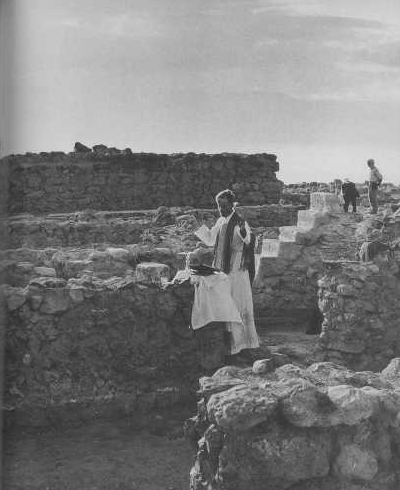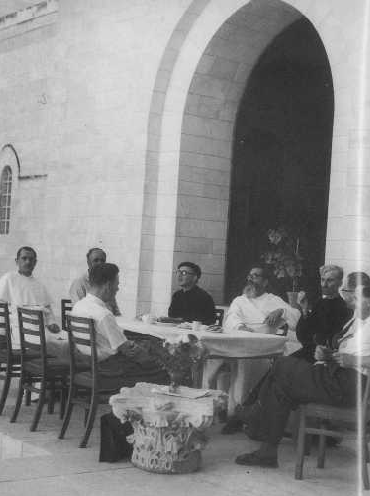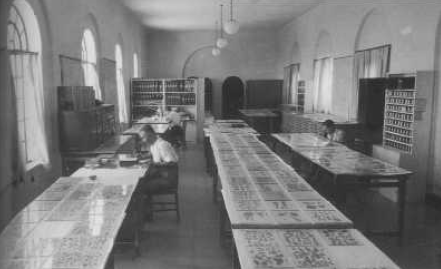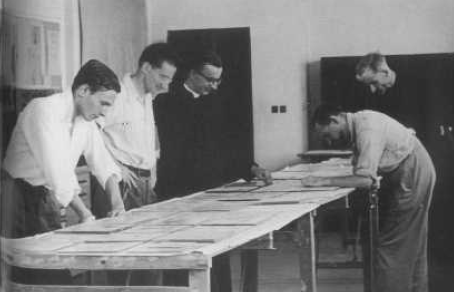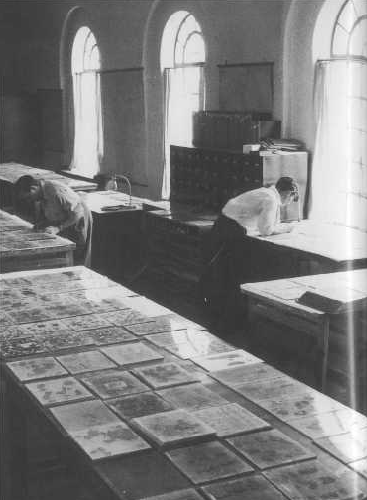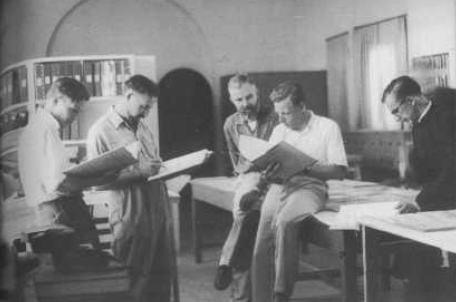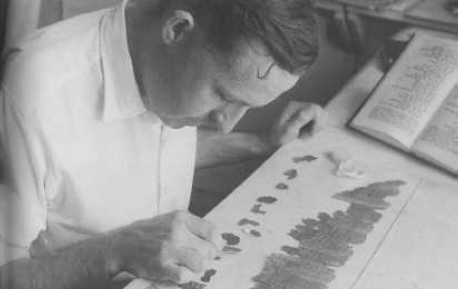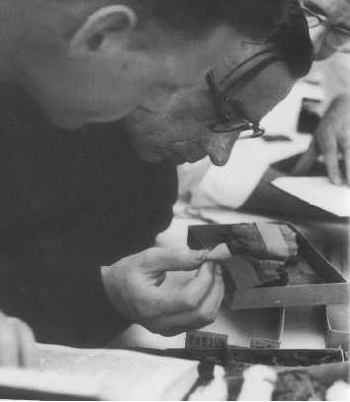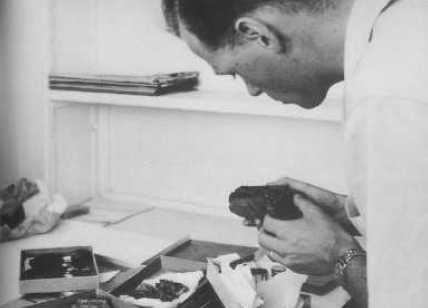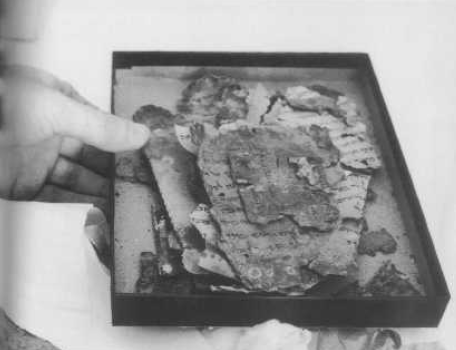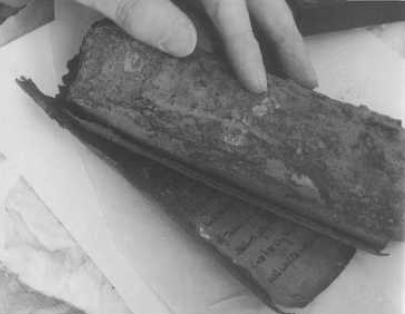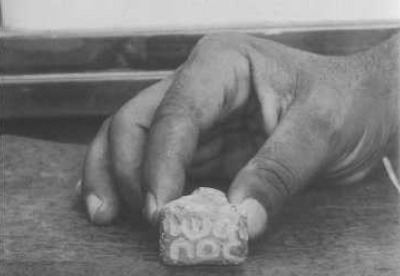|
6 -
The Onslaught of Science
We wondered why
this association should constantly be made. Why were the
international team and the Ecole Biblique treated as though they
were the same thing? What was the relationship between them? Was it
formally defined and delineated? Was the international team
'officially' an adjunct of the Ecole Biblique? Or was the overlap
between them so great as to render any distinction superfluous? With
some advice and pointers from Eisenman, we endeavored to clarify
the matter.
Even Strugnell
stated that when fresh material came in, Milik would invariably
pounce on it, claiming it fell within the parameters of his own
particular assignment.2
Father Skehan, though not permanently resident in Jerusalem, threw his weight behind this triumvirate. So did Professor Cross - who had been assigned 'biblical' rather than 'sectarian' material anyway. Allegro, of course, cast himself in the role of rebel, but his opposition was hampered by the fact that he was in Jerusalem only intermittently. Of those residing in Jerusalem during the crucial period of excavation, purchase of material, allocation of texts and collation of fragments, only the young John Strugnell (who would hardly have challenged de Vaux anyway) was not Catholic - and he subsequently converted.
All the others were, in
fact, Roman Catholic priests, attached to, and residing at, the Ecole Biblique. Among the other current members of the team or
writers in the area of Qumran studies working at the Ecole are
Father Emile Puech and Father Jerome Murphy-O'Connor.
The Ecole had its own journal, for example, Revue biblique, edited by de Vaux, who published in its pages some of the most consequential and influential early articles on Qumran - articles bearing the stamp of first-hand authority. And in 1958, the Ecole launched a second journal, Revue de Qumran, devoted exclusively to the Dead Sea Scrolls and related matters. Thus the Ecole officially controlled the two most prominent and prestigious forums for discussion of Qumran material.
The Ecole's editors could
accept or reject articles as they saw fit, and were thereby enabled
to exert a decisive influence on the entire course of Qumran
scholarship. This situation was inaugurated at the very inception of
Qumran studies.
The Ecole became the
'headquarters', the 'offices', the 'school' and the 'nerve centre'.
Thus the Ecole contrived to establish itself as the de facto and
generally recognized centre of all Qumran scholarship, the focus of
all legitimate and academically respectable research in the field.
The Ecole's 'stamp of approval' could, in effect, underwrite,
certify and guarantee a scholar's reputation. Withholding such
endorsement was tantamount to destroying a man's credibility.
The real question was whether his
scholarship, and its reliability, had anything to fear from his
faith.
By virtue of John Allegro's success in persuading the Jordanian government to nationalize the Rockefeller Museum,4 and political and military circumstance - the Six Day War and its aftermath - Israel suddenly found itself, as a fait accompli, in possession of Arab East Jerusalem, where the Rockefeller Museum and the Ecole Biblique were situated. As 'spoils of war', the Dead Sea Scrolls thus became de facto Israeli. But Israel was fighting for its own survival at the time. In the turmoil of the moment, there were more urgent matters to deal with than the sorting out of scholarly disputes or the rectifying of academic inequities.
Neither could Israel afford to
isolate itself further on the international scene by antagonizing a
body of prestigious researchers and thereby provoking a reaction
from the intellectual community - as well, quite possibly, as from
the Vatican. In consequence, the Israeli government had taken the
expedient course of doing nothing, of implicitly sanctioning the
status quo. The international team had simply been asked to get on
with their business.
These factors undoubtedly played a part. But the real question was one of accountability. To whom, ultimately, were the international team accountable? In theory, they should have been accountable to their peers, to other scholars. But was that indeed the case? In reality, the international team seemed to recognise no accountability whatever, except to the Ecole Biblique. And to whom was the Ecole Biblique accountable?
Although
he'd not investigated the matter himself, Eisenman prompted us, when
we probed him, to explore the connection between the Ecole and the
Vatican.
According to Professor Golb at the University of Chicago,
Like his colleagues, however, he had not
explored the matter any further. Given the Ecole's undisputed
dominance of Qumran scholarship, it seemed to us particularly
important to ascertain the institution's official orientation,
attitudes, allegiances and accountability. Here, we decided, was
something we ourselves could undertake to investigate in detail. The
results were to prove a major revelation, not just to us, but to
other independent researchers in the field as well.
The 'field', such as it was, existed
not as a sphere of formal academic study but as a happy
hunting-ground for learned - and often not so learned - amateurs.
The territory was as yet too uncharted to accommodate anything that
might be called 'professionalism'.
Knowledge of the past was deemed less important than whatever booty it might provide; and funds for the plundering of such booty were supplied by, or for, various museums in quest of large and dramatic statues to place on display. Public demand for relics of this sort was considerable. Crowds would flock to museums to see the latest trophies, and the popular press would have a field day. But the trophies themselves were more an inspiration to the imagination, and to imaginative speculation, than to any form of scientific method.
Flaubert's Salammb˘, for example, published in
1862, represents an extraordinary feat of 'literary archaeology', a
grandiose imaginative attempt to reconstruct, with meticulous
scientific precision, the splendor of ancient Carthage. But science
itself had not yet caught up with Flaubert's aesthetic objectives.
Certainly no historian had ever attempted to use scientific or
archaeological data to bring ancient Carthage so vividly back to
life.
The Trojan War, Schliemann insisted, to the mockery and skepticism of his contemporaries, was an event in historical fact. Troy was not just a figment of a poet's imagination. On the contrary, it had once been a 'real' city. One could use Homer's work as a species of map. One could identify certain recognizable geographical and topographical features.
One could compute approximate speeds of
travel at the time, and thereby estimate the distance between one
point and another cited by Homer. By such means, Schliemann
concluded, one could retrace the itinerary of the Greek fleet in the
Iliad and locate the actual historical site of Troy. After
performing the requisite calculations, Schliemann was firmly
convinced he had found 'the X that marked the spot'.
At what he believed to be the relevant site in Turkey, he began to dig. And to the world's consternation, astonishment and admiration, Schliemann there found Troy - or, at any rate, a city that conformed to Homer's account of Troy. As a matter of fact, Schliemann found a number of cities. In four campaigns of excavation, he uncovered no fewer than nine, each superimposed on the ruins of what had been its predecessor. Nor, after this initial spectacular success, did he confine himself to Troy.
A few years
later, between 1874 and 1876, he excavated at Mycenae in Greece,
where his discoveries were deemed to be perhaps even more important
than those made in Turkey.
In addressing himself to the nine superimposed cities at Troy,
Schliemann employed the same techniques that had only recently come
into favor in geological studies. These enabled him to conclude
what to the modern mind appears self-evident - that one stratum of
deposits can be distinguished from others on the basic premise that
the lowest is the earliest in time. Schliemann thus became the
pioneer of the archaeological discipline known as 'stratigraphy'.
Almost single-handed, he revolutionized archaeological thought and
methodology.
His endeavors
inspired him to help co-found the Palestine Exploration Fund, the
chief patron of which was no less a person than Queen Victoria
herself. At first, the work of this organization proceeded in a
characteristically uncoordinated fashion. At the 1886 annual
meeting, however, Wilson announced that 'some of the wealthy men of
England would follow Dr. Schliemann's example' and apply his
scientific approach to a specific biblical site.8 The enterprise was
entrusted to the charge of a prominent archaeologist then active in
Egypt, William Matthew Flinders Petrie. Adopting Schliemann's
methods, Flinders Petrie, after two false starts, discovered a mound
containing the ruins of eleven superimposed cities.
Although certainly not
foolproof, Petrie's approach brought another manifestation of
scientific methodology and observation to bear on archaeological
research. It became one of the standard procedures employed by his
team in Palestine - a team which, in 1926, was joined by the young
Gerald Lankester Harding. As we have noted, Harding, eventually head
of Jordan's Department of Antiquities, was to play a crucial role in
the early excavation and compilation of the Dead Sea Scrolls.
This, needless to say,
was a slow, painstaking process, requiring much care and
inexhaustible patience. It did not just involve the excavation of
'treasures', or of monumental structures. It also involved the
excavation and reconstruction of administrative, commercial and
residential buildings. Using this approach, Robert Koldeway, between
1899 and 1913, excavated the ruins of Babylon. From his work, there
evolved a coherent and comprehensively detailed picture of what had
previously, to all intents and purposes, been a 'lost civilization'.
Born in 1823, Renan embarked on a career in the priesthood, enrolling in the seminary of St Sulpice. In 1845, however, he renounced his intended vocation, having been led by Germanic biblical scholarship to question the literal truth of Christian teaching. In 1860, Renan embarked on an archaeological journey to Palestine and Syria.
Three years later, he published his famous (or notorious) La vie de JÚsus, {The Life of Jesus), which was translated into English the following year. Renan's book sought to demystify Christianity. It portrayed Jesus as 'an incomparable man', but still a man - an eminently mortal and non-divine personage - and formulated a hierarchy of values which today would be called a form of 'secular humanism'. Renan was no obscure academic or fly-by-night sensationalist. On the contrary, he was one of the most esteemed and prestigious intellectual figures of his age.
As a result, The Life of Jesus created one of the greatest upsets in the history of 19th-century thought. It became one of the half-dozen or so best-selling books of the entire century, and has never subsequently been out of print. For the 'educated classes' of the time, Renan became as much a household name as Freud or Jung might be today; and, in the absence of television, he was probably much more widely read.
At a single stroke, The Life of Jesus transformed
attitudes towards biblical scholarship almost beyond recognition.
And for the next thirty years of his life, Renan was to remain a
thorn in the Church's side, publishing subsequent works on the
Apostles, on Paul and on early Christianity in the context of
imperial Roman thought and culture. He produced two epic series of
texts, Histoire des origines du christianisme (1863-83) and
Histoire du peuple d'Israel (1887-93). It is no exaggeration to say that
Renan released from its bottle a genie which Christianity has never
since managed to recapture or tame.
In Darwin's wake, there followed the great age of English agnosticism, exemplified by Thomas Huxley and Herbert Spencer. Influential and widely read philosophers - Schopenhauer, for example, and particularly Nietzsche - were also challenging, even blasphemously demolishing, conventional Christian ethical and theological assumptions.
Under
the doctrine of 'l'art pour l'art', the arts were becoming
established as a self-contained religion of their own, moving into
sacred territory which organized religion seemed increasingly to
have abdicated. Bayreuth became, in effect, the temple of a new
cult, a new creed; and well-educated Europeans deemed it quite as
acceptable to be 'a Wagnerian' as to be a Christian.
Most traumatic of all, Garibaldi's partisan army, by 1870, had finally effected the unification of Italy - had captured Rome, had wrested the Papal States and all other territory from the Church, and reduced Catholicism to the status of a non-secular power.
16 Father Jean Starcky celebrating Mass at the ruins of Qumran Centre, bearded, is Father de Vaux, with Father Milik to his right
and Father Starcky to
his left. John Allegro is seated to the right of the illustration. Beleaguered by onslaughts from science, from philosophy, from the arts and from secular political powers, Rome was more shaken than she had been at any time since the beginning of the Lutheran Reformation three and a half centuries before.
She responded with a number of desperate defensive measures. She sought - vainly, it inspired - political allegiances with Catholic, or nominally Catholic, powers, such as the Habsburg Empire. On 18 July 1870, after a vote by the First Vatican Council, Pope Pius IX - characterized by Metternich as 'warm of heart, weak of head and lacking utterly in common sense'9 - promulgated the dogma of Papal Infallibility.10
And to counter the depredations being wrought on
scripture by Renan and German biblical scholarship, the Church began
equipping her own cadres of meticulous scholars - elite intellectual
'shock troops' who were supposed to confront Catholicism's
adversaries on their own ground. Thus arose the Catholic Modernist
Movement.
To Rome's chagrin and
mortification, however, the program backfired. The more it sought
to arm younger clerics with the requisite tools for combat in the
modern polemical arena, the more those same clerics began to desert
the cause for which they had been recruited. Critical scrutiny of
the Bible revealed a multitude of inconsistencies, discrepancies and
implications that were positively inimical to Roman dogma. The
Modernists themselves quickly began to question and subvert what
they were supposed to be defending.
Loisy argued that many points of dogma had
crystallized as
historically conditioned reactions to specific events, at specific
places and times. In consequence, they were not to be regarded as
fixed and immutable truths, but as - at best - symbols. According to
Loisy, such basic tenets of Christian teaching as the Virgin Birth
and Jesus' divinity were no longer tenable.
In The Saint, published in 1905, Fogazzaro wrote:
Fogazzaro's work, needless to say, was itself promptly placed on the Index. And the Church's campaign against the movement it had fostered and nurtured proceeded to intensify. In July 1907, the Holy Office published a decree officially condemning Modernist attempts to question Church doctrine, papal authority and the historical veracity of biblical texts. Less than two months later, in September, Modernism was effectively declared to be a heresy and the entire movement was formally banned.
The number of books on the
Index suddenly and dramatically increased. A new, much more
stringent censorship was instituted. Clerical commissars monitored
teaching with a doctrinal rigidity unknown since the Middle Ages. At
last, in 1910, a decree was issued requiring all Catholics involved
in teaching or preaching to take an oath renouncing 'all the errors
of Modernism'. A number of Modernist writers were excommunicated.
Students at seminaries and theological colleges were even forbidden
to read newspapers.
The Ecole Biblique et Archeologique Franchise de Jerusalem - which subsequently came to dominate Dead Sea Scroll scholarship - was rooted in the first generation of Modernism, before the Church realized how close it had come to subverting itself. It originated in 1882, when a French Dominican monk on pilgrimage in Jerusalem resolved to establish a Dominican house there, consisting of a church and a monastery.
He
chose a site on the Nablus Road, where excavations had revealed the
remains of an earlier church. According to tradition, it was
precisely here that St Stephen, supposedly the first Christian
martyr, had been stoned to death.
The 25-year-old Lagrange had accordingly gone to Salamanca, in Spain, where he studied Hebrew and taught Church history and philosophy. It was at Salamanca that he was ordained a priest, on St Dagobert's Day (23 December), 1883. In 1888, he was sent to the University of Vienna to study Oriental languages. Two years later, on 10 March 1890, at the age of thirty-five, he arrived at the fledgling Dominican house of St Stephen in Jerusalem, and there, on 15 November, established a biblical school.
The school was called initially the 'Ecole Practique d'Etudes Bibliques'. Lagrange created for it its own journal, Revue biblique, which began publication in 1892 and continues today. Through this organ, as well, of course, as through the program of studies, he sought to imbue the new institution with an attitude towards historical and archaeological research which can best be summed up in his own words.
According to Father Lagrange,
The Old Testament was,
The orientation was clear
enough. To the extent that Lagrange employed modern methodology at
all, he would employ it to 'prove' what he had already, a priori,
decided to be true - that is, the literal veracity of scripture. And
the 'definitive' nature of the New Testament and the events it
chronicled rendered it effectively off limits to scholarly scrutiny.
The Ecole Biblique,
originally created as a forum for Modernism, had now become a
bulwark against it.
In 1956, he played a key role in organizing the letter to
The Times that was intended to isolate and discredit John Allegro.
15
Writing in 1966, Father Skehan declared that the Old Testament was not,
In other words, the primary responsibility of every biblical scholar is to ferret out from the Old Testament supposed anticipations of accepted Christian doctrine. Viewed any other way, the Old Testament presumably has scant value and relevance. This is a curious definition of 'dispassionate scholarship'.
But Father Skehan was even more explicit:
Father Skehan, of course, made no real pretence to 'dispassionate scholarship'. In fact, he regarded it as positively dangerous - considering that 'studies carried out from a perspective that puts literary and historico-critical considerations in the foreground can, usually in the hands of popularizers, result in oversimplification, exaggeration, or neglect of more profound matters'.18
Ultimately, the biblical scholar's work should be guided
and determined by Church doctrine and 'be subject always to the
sovereign right of Holy Mother Church to witness definitively what
is in fact concordant with the teaching she has received from
Christ'.19
As for the Ecole Biblique and its research on the Dead Sea Scrolls, Skehan says:
For years, most independent scholars were quite unaware of any such divine mandate having been possessed by the Ecole Biblique, or of the Vatican's wishful thinking on the matter. On the contrary, the Ecole appeared to be an impartial scholarly institution dedicated, among other things, to collecting, collating, researching, translating and elucidating the Dead Sea Scrolls, not for suppressing them or transforming them into Christian propaganda.
Thus, for example, a scholar or graduate student in Britain, or the States, or anywhere else, having established some academic credibility with a thesis or publication in one or another sphere of biblical study, would apply for access to the Qumran material. He'd have no reason to expect a rebuff - would assume the scrolls were available for study by anyone who had acquired legitimate academic credentials.
In every case known to us, however, requests for access
have been summarily refused, without apology or explanation - and
with the inevitable concurrent implication that the applicant
himself was somehow inadequate.
In 1970, he was in Jerusalem and accordingly wrote to de Vaux, then head of the Ecole Biblique and the international team, requesting access and explaining that he needed it to validate a research project which had already occupied years of his life. Three days later, de Vaux replied, stating that no access could be granted without 'the explicit permission of the scholar who is in charge of their edition'.22
The scholar in question was the then Father Milik, who, as de Vaux knew only too well, wasn't prepared to let anyone see anything. After all the time and effort he had invested in it, Golb was obliged to abandon his project.
On the other hand, fragments of Qumran material will be made available to researchers affiliated with the Ecole itself, to young scholars and protÚgÚs of the international team, to graduate students under the tutelage of one or another team member, who can be assured of toeing the official 'party line'. Thus, for instance, Eugene Ulrich of Notre Dame, a student of Cross's, 'inherited' the scroll material originally assigned to Father Patrick Skehan.
He also appears to have inherited something of Skehan's attitude to other scholars. When asked why facsimile photographic editions couldn't be produced, he replied that,
Independent scholars from Britain, the States and elsewhere have thus found it impossible to get access to unpublished scroll material. For Israeli scholars, such access has been inconceivable. As we have noted, Father de Vaux, a former member of the notorious Action Franchise, was a fairly outspoken anti-Semite. To this day, members of the Ecole Biblique seem to remain hostile to Israel, even though it is supposed in theory to be a neutral enclave for impartial scholarship, a refuge from the political and religious divisions rending modern-day Jerusalem.
When asked why no scholars from Tel Aviv University were involved in editing the scrolls, Strugnell replied:
With his characteristic, and self-incriminating, eloquence, the late Father Skehan effectively articulated his and his colleagues' anti-Israeli bias in a letter quoted in Jerusalem Post Magazine:
As we have noted, this attitude is shared by the former Father Milik. Neither he nor another of his colleagues, the late Father Starcky, ever returned to Jerusalem after the 1967 war, when the scrolls passed into Israeli hands. Then again, of course, their position only echoes that of the Vatican itself, which, even today, does not recognize the State of Israel.
But one is prompted to ask whether their prejudice simply coincided with official Church policy, or whether it was formally dictated by the ecclesiastical hierarchy.
|
